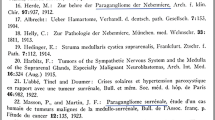Abstract
Calcitonin mRNA was detected in human and monkey carotid bodies by in situ hybridization histochemistry, using a 35S-labeled oligonucleotide probe for human calcitonin. In both human and monkey carotid body, moderate to high hybridization signal for calcitonin mRNA was observed in all cases. The hybridization signal in the formalin-fixed, paraffin-embedded samples was comparable to that obtained from frozen paraformaldehyde-fixed tissue. Our observations extend the finding of calcitonin-like immunoreactivity in the carotid body chief cells and indicate that calcitonin is produced in the carotid body, probably in the chief cells.
Similar content being viewed by others
References
Becker KL, Snider RH, Moore CF, Monaghan KG, Silva OL (1979) Calcitonin in extrathyroidal tissues of man. Acta Endocrinol 92:746–751
Becker KL, Monaghan KG, Silva OL (1980) Immunocytochemical localization of calcitonin in Kulchitsky cells of human lung. Arch Pathol Lab Med 104:196–198
Boyd JD (1937) The development of the human carotid body. In: Contribution to Embryology. Carnegie Institution of Washington 26:1–31
Cooper CW, Schwesinger WH, Mahgoub AM, Ontjes DA (1971) Thyrocalcitonin: stimulation of secretion by pentagastrin. Science 172:1238–1243
Copp DH, Cameron EC, Cheney BA, Davidson AGT, Henze KG (1964) Evidence for calcitonin-a new hormone from the parathyroid. Endocrinology 70:638–649
Craig RK, Hall L, Edbrooke MR, Allison J, MacIntyre I (1982) Partial nucleotide sequence of human calcitonin precusor mRNA identifies flanking cryptic peptides. Nature 295:345–347
Cross BA, Corfield DR, Howells KD, Stidwill RP, Newman GB, Semple SJ (1990) Carotid chemoreceptor response to increase in CO2 output. Respir Physiol 81:99–115
Cuello AC, McQueen DS (1980) Substance-P: a carotid body peptide. Neurosci Lett 17:215–219
Cutz E, Chan W, Track NS (1981) Bombesin, calcitonin and leuenkephalin immunoreactivity in endocrine cells of human lung. Experientia 37:765–767
Deftos LJ, Lee MR, Potts JT Jr (1968) A radioimmunoassay for thyrocalcitonin. Proc Natl Acad Sci USA 60:293–299
Denijn M, De Weger RA, Berends MJH, Compier-Spies PhI, Jansz H, Van Unnik JAM, Lips CJM (1990) Detection of calcitoninencoding mRNA by radioactive and non-radioactive in situ hybridization: improved colorimetric detection and cellular localization of mRNA in thyroid sections. J Histochem Cytochem 38:351–358
Driman D, Murray D, Kovacs K, Stefaneanu L, Higgins HP (1991) Encapsulated medullary carcinoma of the thyroid. A morphologic study including immunocytochemistry, electron microscopy, flow cytometry, and in situ hybridization. Am J Surg Pathol 15:1089–1095
Hirsch PF, Voelkel EF, Munson PL (1964) Thyrocalcitonin: hypocalcemic hypophosphatemic principle of the thyroid gland. Science 146:412–413
Hsu S-M, Raine L, Fanger H (1981) The use of avidin-biotin-peroxidase complex (ABC) in immunoperoxidase techniques: a comparison between ABC and unlabeled antibody (PAP) procedures. J Histochem Cytochem 29:577–580
Lewis ME, Sherman TG, Burke S, Akil H, Davis LG, Arentzen R, Watson SJ (1986) Detection of proopiomelamocortin mRNA by in situ hybridization with an oligonucleotide probe. Proc Natl Acad Sci USA 83:5419–5423
Lloyd RV, Field K, Jin L, Horvath E, Kovacs K (1990) Analysis of endocrine active and clinically silent corticotropic adenomas by in situ hybridization. Am J Pathol 137:479–488
MacInnes DG, Laszlo I, MacIntyre I, Fink G (1982) Salmon calcitonin in lizard brain: A possible neuroendocrine transmitter. Brain Res 251:371–373
McDonald DM (1981) Peripheral chemoreceptors. Structures-function relationships of the carotid body. In: Hornbein TF (ed) Regulation of breathing (lung biology in health and disease, vol 17, pt 1). Marcel Dekker, New York, pp 105–319
Moore KL (1988) The developing human. Clinically oriented embryology, 4th edn. Saunders, Philadelphia, pp 184–186
Mougin C, Guitteny AF, Fouque B, Viennet R, Teoule R, Bloch B (1990) Histochemical detection of the messenger RNAs coding for calcitonin and calcitonin gene-related peptide in medullary thyroid carcinomas with radioactive and biotinylated oligonucleotide probes. J Pathol 160:187–194
Niewoehner DE, Levine AS, Morley JE (1981) Central effects of neuropeptides on ventilation in the rat. Clin Res 29:774A
Perrin DG, Chan W, Cutz E, Madapallimatum A, Sole MJ (1986) Serotonin in the human infant carotid body. Experientia 42:562–564
Smith P, Gosney J, Heath D, Burnett H (1990) The occurrence and distribution of certain polypeptides within the human carotid body. Cell Tissue Res 261:565–571
Tsutsumi Y (1989) Immunohistochemical analysis of calcitonin and calcitonin gene-related peptide in human lung. Hum Pathol 20:896–902
Wang YY, Perrin DG, Cutz E (1993) Localization of cholecystokinin-like and calcitonin-like peptides in infant carotid bodies: a light and electronmicroscopic immunohistochemical study. Cell Tissue Res 272:169–174
Wharton J, Polak JM, Pearse AGE, McGregor GP, Bryant MG, Bloom SR, Emson PC, Bisgard GE, Will JA (1980) Enkephalin-, VIP- and substance P-like immunoreactivity in the carotid body. Nature 284:269–271
Author information
Authors and Affiliations
Rights and permissions
About this article
Cite this article
Wang, Y.Y., Cutz, E. & Perrin, D.G. Detection of calcitonin gene expression in human infant and monkey carotid body chief cells by in situ hybridization. Cell Tissue Res 276, 399–402 (1994). https://doi.org/10.1007/BF00306125
Received:
Accepted:
Issue Date:
DOI: https://doi.org/10.1007/BF00306125




